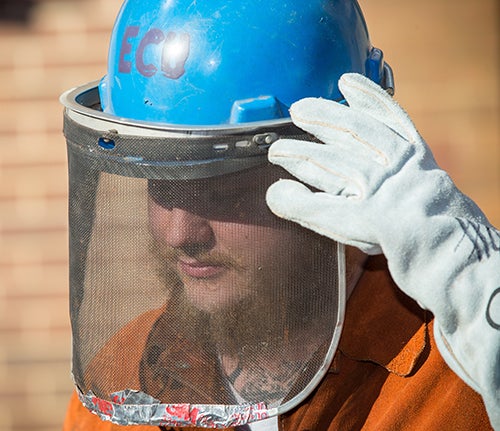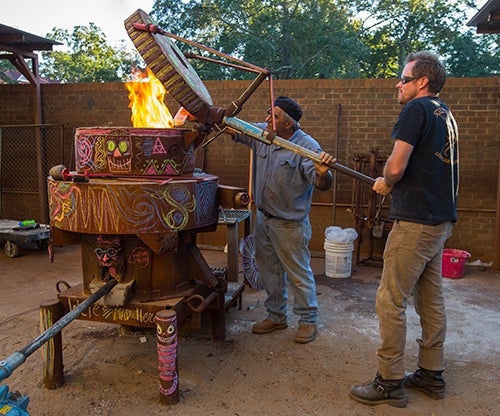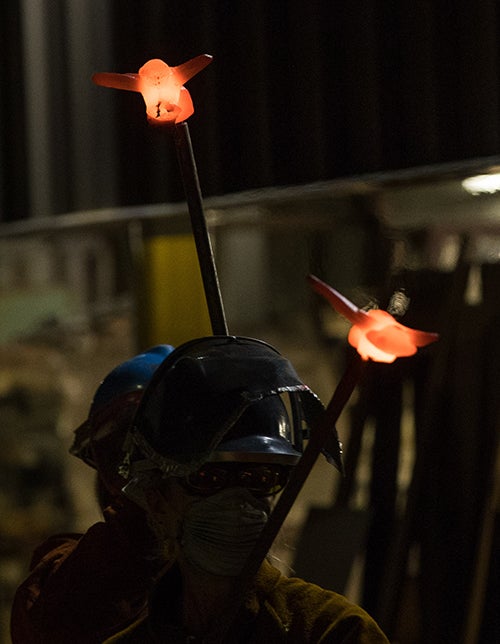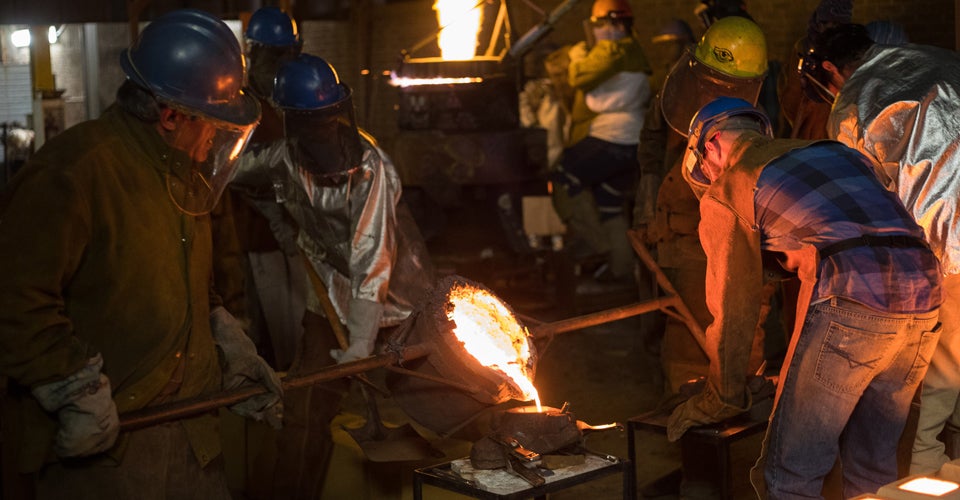CROSS-POLLINATION
Teamwork supports ECU iron pour project
Much like a colony, East Carolina University sculpture students became worker bees at an Oct. 29 iron pour and public performance.
Visiting artist Allen Peterson of Atlanta led the performance with ECU’s School of Art and Design titled “Carolina Cross-pollination,” based on the natural behaviors of honeybees.
Five-foot metal rods were inserted into the cast bee molds, and once hardened, the students “flew” the bees across the ECU sculpture yard in a glowing nighttime exhibition.
“It’s based on movements that bees do in the hive,” Peterson said.

ECU students wearing protective clothing get ready for the annual ECU iron pour.
Dressed in layers of protective clothing, gloves and steel-toe shoes, ECU students and faculty said teamwork is a big component of the iron pour.
“The neat thing about sculpture is it’s such a sense of community,” said Chris Morgan, one of about 15 sculpture students participating in the event. “Sculptors have to work together.”
The hive of activity was the multi-layer cold blast furnace, which reduces and changes iron oxides into liquid iron called hot metal. Students dumped iron and coke (clean coal) that they had already broken into small pieces into the top of the cylinder while air was blown into the bottom, heating the iron to about 3,000 degrees before liquefying to fill about 40 molds.
“We cast over 1,500 pounds of iron, all student molds,” said art professor Hanna Jubran.

Guest artist Allen Peterson assisted ECU art professor Hanna Jubran before the start of the iron pour.
All the iron used is recycled and cleaned radiators, pipes, sinks or bathtubs, he said.
Students had been planning the event since the beginning of the semester. Each student was expected to have at least one mold although some had as many as five or six. Students of ECU alumnus and Pitt Community College instructor Matt Amante also cast molds for the iron pour.
“All had good results,” Jubran said. “I do it for the students. For them, this is an experience that they may not do again.”
Combining Peterson’s visit and the annual iron pour gave students an opportunity to learn from a working artist and advocate for honeybees. Some of the pieces will be sold at the holiday show to be held the first weekend of December.
The iron pour represents a community as well as an artistic medium, Peterson said.
“There’s something magical about it. There’s a teamwork and camaraderie that goes into pouring iron,” Peterson said. “I was interested in bees as a metaphor for community.”

Students fly honeybees around the ECU sculpture yard in a nighttime performance of “Carolina Crosspollination.”
Peterson said colony collapse disorder heightened his interest in honeybees, food systems and agriculture. During the winter of 2006-2007, some beekeepers began to report unusually high losses of 30 to 90 percent of their hives, according to the EPA website. Recent data shows while colony loss has declined, the causes of colony collapse disorder and honeybee health are still being studied.
“We’ve got to rethink what we’re doing. Saving the bees is important to all our prosperity,” Peterson said.
The ECU Sculpture Guild sponsored Peterson’s visit Oct. 27-29. The Atlanta-based Peterson holds a bachelor of fine arts in painting from Birmingham-Southern College and a master of fine arts in sculpture from the University of Minnesota. His work is featured in several public art displays and collections in the Southeast and internationally. More information is at www.allenpeterson.com.
